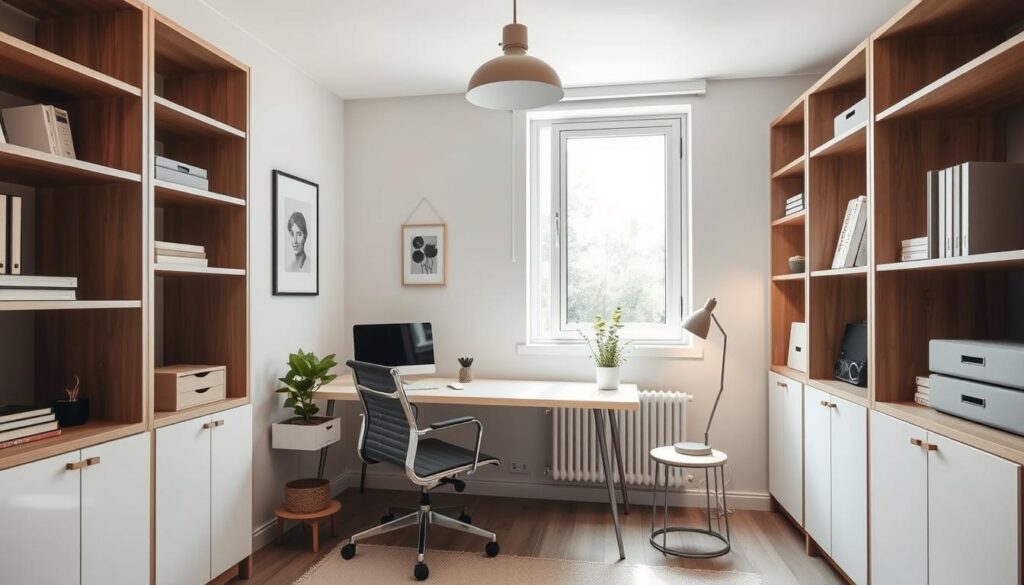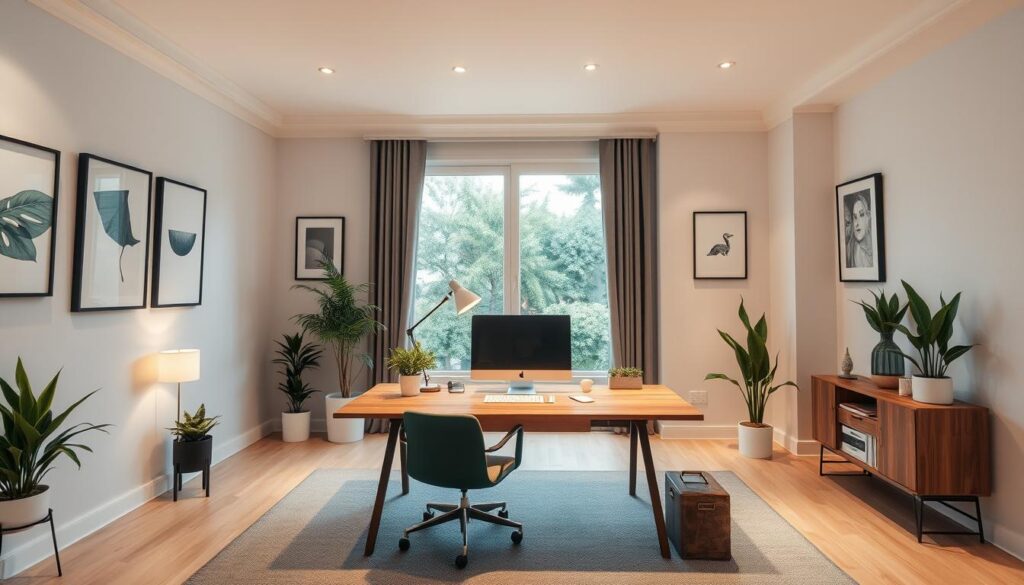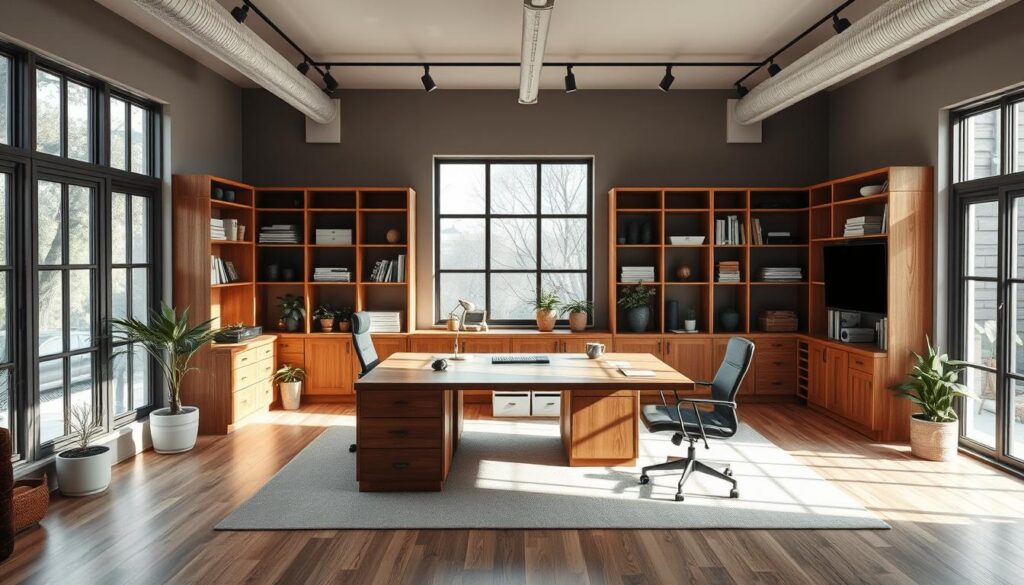More people work from home than ever before. Having a good workspace at home is key for staying productive and comfortable. Many remote workers say their workspace greatly affects their work quality.
We think a well-designed home office can really change things. In this article, we’ll share our best tips for creating a workspace that’s both functional and stylish. It should meet your needs and make your work better.
Key Takeaways
- Create a dedicated workspace
- Choose ergonomic furniture
- Maximize natural light
- Minimize distractions
- Incorporate plants for a calming atmosphere
- Use a color scheme that boosts productivity
Understanding the Importance of a Home Office
A well-designed home office is key to working well and keeping a healthy work-life balance. With more people working from home, having a dedicated space is essential.
Benefits of a Dedicated Workspace
A dedicated home office boosts productivity, focus, and time management. It helps us keep work and personal life separate. This reduces distractions and boosts efficiency.
Some key advantages of a dedicated workspace include:
- Increased productivity: A well-organized space helps us stay on task and meet our goals.
- Enhanced creativity: A home office can be made to spark creativity, with art, plants, or unique decor.
- Better work-life balance: Separating work and personal spaces helps us keep our lives in balance.
Enhancing Productivity and Focus
To boost productivity and focus in our home office, we need to remove distractions. We can do this by using office workspace ideas like clearing clutter, wearing noise-cancelling headphones, or adding plants. Plants improve air quality and help our minds.
A modern home office should also be ergonomic. This means it should be comfortable for long hours of work. Invest in a good chair, position your computer right, and make sure the lighting is good.
By understanding the value of a home office and making it productive and focused, we can create a space that inspires us to do our best work.
Choosing the Right Location
The spot where you set up your home office matters a lot. It affects how well you work and how happy you feel. When designing a small office interior, pick a place that helps you stay productive and comfortable.
Think about natural light, noise levels, and how close it is to your daily routines. Let’s explore how to pick the best spot for your work area.
Evaluating Natural Light and Noise Levels
Natural light is key in any home office. It saves on electricity and makes you feel better. Look for spots that get lots of sunlight. Think about your home’s layout and where windows are.
Quiet is also important for good work. Check out how noisy different spots in your home are. You might need to use soundproofing or noise-cancelling gadgets.
Proximity to Daily Activities
How close your office is to daily life can affect your work. Being too near the kitchen or living room can be distracting. But being too far away can make it hard to connect with family.
Find a spot that’s easy to get to but not too busy. This way, you can focus on work and still take breaks to hang out with family.
Adding office decor ideas that are calming and inspiring can also help. Think about adding plants, art, or personal touches to make your space welcoming and cozy.
By carefully choosing your location, you can make a home office that’s both useful and enjoyable. The secret to a great home office is finding a spot that fits your needs perfectly.
Defining Your Office Needs and Goals
To design a home office that truly works for you, start by understanding your needs and goals. Look closely at how you work and what you need to stay productive.
Identifying Your Work Style
Your work style is key to choosing the right home office. Do you need lots of space or a minimalist setup? Think about how you work: Is it mostly on the computer or with paperwork? Knowing your work habits helps create a space that boosts your productivity.
For example, writers might need a quiet area with a comfy desk and chair. Graphic designers might need more space for multiple monitors and design tools.
“The way we work is changing, and our workspaces need to adapt to these changes. It’s not just about having a desk and a chair; it’s about creating an environment that fosters creativity and productivity.”
Assessing Space and Equipment Requirements
After understanding your work style, assess your space and equipment needs. Measure your available space and think about how to use it best. Consider the layout of your home office to optimize it for your needs.
Make a list of the essential equipment for staying productive. This includes a reliable computer, a comfy chair, and enough storage for papers and supplies. A well-organized home office keeps you focused and avoids distractions.
| Equipment | Considerations |
|---|---|
| Computer | Processor speed, memory, and storage capacity |
| Chair | Ergonomic design, comfort, and adjustability |
| Storage | Type, size, and accessibility |
By thinking about your work style and assessing your needs, you can create a home office that’s both functional and stylish. This setup helps you stay organized, focused, and productive all day.
Selecting the Perfect Furniture
Finding the right furniture is crucial for a comfy and productive home office. The furniture you pick affects your comfort and how well you work. It’s important to think about both how well it works and how it looks to make a space that helps you succeed.
Ergonomic Chairs and Desks
Ergonomic furniture is key for staying comfortable and avoiding injuries during long workdays. Ergonomic chairs need to support your back and adjust to fit you. Ergonomic desks let you work comfortably, whether sitting or standing.
Choosing a good ergonomic chair and desk can boost your productivity and health. Look for chairs with breathable fabric and adjustable armrests. Desks with cable management systems help keep your space organized.
Multi-Functional Storage Solutions
Good storage is essential for a clean home office. Multi-functional storage solutions like desks with drawers or shelves keep things organized. Use wall-mounted shelves to make the most of your space.
Think about what you need to store when picking storage. For things you use often, make sure they’re easy to get to. For items you don’t use as much, choose storage that’s out of the way but still accessible. This keeps your office tidy and efficient.
By picking ergonomic chairs and desks, and multi-functional storage, you can make a home office that works well and looks good. This will make your work experience better and more enjoyable.
Creating an Inspiring Atmosphere
An inspiring home office is essential for your best work. The right atmosphere can boost your mood, motivation, and productivity.
To make your workspace inspiring, focus on design elements. Think about color psychology and adding personal touches.
Color Psychology in Home Office Design
Colors deeply affect our feelings and work. They can either energize or calm us, making color choice crucial.
- Blue tones help you focus and stay calm, great for detailed work.
- Green shades reduce eye strain and balance, perfect for long hours.
- Yellow and orange boost creativity and energy, ideal for brainstorming.
Choose colors based on your work type. Creative fields might benefit from bright colors like yellow or orange.
Incorporating Personal Elements and Décor
Adding personal touches makes your office welcoming and inspiring. It also reduces stress and boosts your mood.
Here are some ideas for personalizing your space:
- Hang family photos or artwork that means something to you.
- Bring in plants or natural elements for calm and connection.
- Use decorative storage that shows your style and keeps things organized.
A tidy space helps clear your mind. But, it should also reflect your personality. Finding a balance between order and personal flair is key.
“The way we spend our time defines who we are, and our workspace should reflect that.”
Designing your home office with color and personal touches creates a space that inspires. It becomes your ideal modern home office.
Maximizing Space Efficiency
Maximizing space in your home office is more than saving space. It’s about making your workspace more productive. Whether you have a lot of room or just a little, it’s key to optimize your space.
Tips for Small Home Offices
In small home offices, every inch matters. Here are some tips to make the most of your space:
- Opt for multi-functional furniture: Furniture that does more than one thing can cut down on clutter and boost functionality.
- Utilize corners: Corner desks, shelves, and storage can turn unused corners into useful space or storage.
Utilizing Vertical Space and Storage
Using your walls can greatly increase storage and workspace. Think about:
- Wall-mounted shelves: For books, decorations, or office supplies, keeping your desk clear.
- Vertical filing systems: To keep important documents organized and easy to access.

By using these strategies, you can make a home office that’s both efficient and cozy, no matter its size.
Integrating Technology Seamlessly
Working from home can be better with the right technology. A good setup makes our work flow smoother, cuts down on distractions, and boosts our efficiency.
We should focus on two main things: Tools for Improved Workflow and Ensuring Connectivity and Organization. Choosing the right tools and keeping our tech connected and tidy helps us make a home office that works well and looks good.
Tools for Improved Workflow
The right tools can really help us work better. Some key tools for a home office include:
- Project management software like Trello or Asana
- Time tracking apps such as Harvest or Toggl
- Video conferencing tools like Zoom or Google Meet
- Cloud storage services like Google Drive or Dropbox
These tools help us stay organized, manage our time well, and work with others from afar.
| Tool | Purpose | Benefits |
|---|---|---|
| Trello | Project Management | Organizes tasks, tracks progress |
| Harvest | Time Tracking | Monitors time spent on tasks, generates reports |
| Zoom | Video Conferencing | Facilitates remote meetings, enhances collaboration |
Ensuring Connectivity and Organization
It’s important to keep our tech connected and organized for smooth work. This means:
- Getting a reliable internet connection
- Buying a good router and modem
- Keeping cables and wires tidy
- Using cloud services for storing and sharing data
By doing these things, we can avoid interruptions, keep our data safe, and keep our workspace clean.
In conclusion, making our home office tech work well is key to being productive and having a stylish space. By picking the right tools and keeping our tech organized, we can make a workspace that’s both useful and looks great.
Lighting Choices for Productivity
When setting up your home office, lighting is key. Good lighting boosts your productivity, comfort, and work experience.

Natural Light vs. Artificial Lighting
Natural light is best for home offices as it lifts your mood and energy. But, it’s not always enough, mainly in rooms with small windows. So, artificial lighting is vital. It’s important to mix natural and artificial light for a cozy and inviting space.
Artificial lighting includes overhead lights, table lamps, and floor lamps. Each has its own role. For example, LED bulbs offer bright, energy-saving light that feels like natural daylight.
Task Lighting and Ambient Options
It’s also important to have task lighting for specific work areas. Task lighting cuts down eye strain and helps you focus. Desk lamps are great for this, as they can be moved to shine where you need it.
Ambient lighting gives the room a general glow, making it feel warm and inviting. This can come from overhead lights and floor lamps. Mixing different lights creates a space that’s both useful and welcoming.
The right lighting can make your home office both productive and comfy. By picking the right mix of natural and artificial light, and task and ambient lighting, you can make a space that boosts your work and well-being.
Establishing a Comfortable Environment
Creating a cozy home office is key for staying productive and feeling good. A space that’s too hot, too cold, or noisy can mess with your focus and work flow.
Climate Control and Ventilation
Keeping your office at a comfy temperature and fresh air is vital for a modern home office. The right temperature helps you stay focused. You might want to get a thermostat to set your ideal temperature.
Good air quality is also crucial. Open windows or use an air purifier to keep the air clean. For a small office interior, simple fans or heaters can work well. Adding plants can also improve air quality and look nice.
Noise Reduction Techniques
Noise can really get in the way of your work. Using noise reduction techniques can make your office a better place to work. Soundproofing materials can block out outside sounds. Or, white noise machines or apps can help you focus by covering up background noises.
If you work in a loud area, noise-cancelling headphones are a great idea. Also, telling family or roommates when you’re working can help keep you focused.
Improving your office with better climate control, air, and less noise makes it more comfy and productive. For more tips on making your office stylish and functional, check out our guide on home office design.
Personalizing Your Work Experience
Making your workspace your own is crucial for creativity and efficiency. A home office that shows your personality and work style boosts productivity and job happiness.
To personalize your home office, try making a vision board. It’s a visual guide of your goals, keeping you focused. Start by picking a corkboard, magazine cutouts, and items that match your goals.
Crafting a Vision Board
Here’s how to make your vision board:
- Know your core values and goals.
- Collect images and words that make you feel good and match your goals.
- Arrange these items in a way that inspires you.
- Hang your vision board where you see it every day, like above your desk.
Julia Cameron, author of “The Artist’s Way,” said, “The creative process is about letting go, not controlling.” A vision board helps you stay on track with your goals.
Incorporating Plants and Nature
Adding plants and nature to your home office also changes your work experience. Plants improve air quality, reduce stress, and make you happier, making them perfect for any office.
Some good plants for offices include:
- Snake plants, which are easy to care for.
- Spider plants, simple to grow and share.
- Peace lilies, which clean the air and add beauty.
These plants make your office not just functional but also inspiring and productive. Adding natural touches like a water feature or rocks and shells can make your space even better.
Personalizing your home office is about making a space that meets your needs. This way, you can have a more productive, creative, and satisfying work life.
Maintaining Work-Life Balance
Creating a stylish office design is not just about looks. It’s also about being functional and keeping a balance between work and life. Working from home can make it hard to separate work and personal time.
To keep a balance, setting clear boundaries is key. This means setting specific work hours and having a dedicated workspace. A well-designed home office helps you stay focused and avoid overworking.
Boundary Setting Strategies
Having a routine is crucial for separating work from personal life. This includes regular working hours, breaks, and a “shutdown” ritual. These help mark the end of the workday.
Staying Organized and Focused
A stylish office design boosts productivity. It inspires you and keeps your space organized. Regularly cleaning and using good storage solutions keeps distractions away.
By using these strategies, you can enjoy a well-designed home office. And still keep a healthy balance between work and life.


